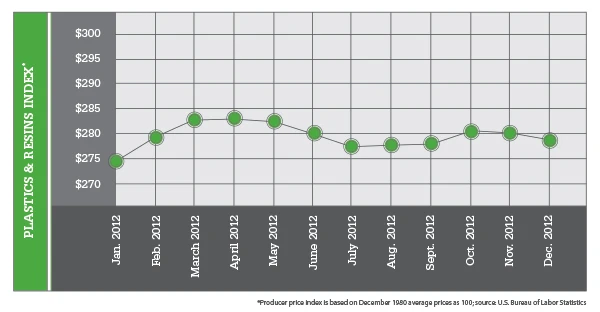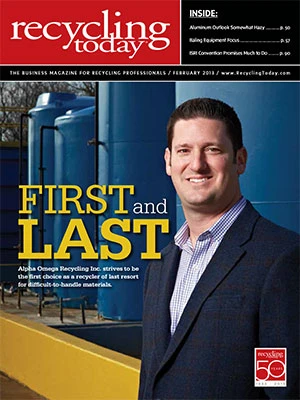
Manufacturing activity appears to have picked up the pace relative to the end of 2012, according to sources, leading to improved scrap generation.
“The start of the new year brings an awakening in the manufacturing sector,” a reprocessor based in the Midwest says. “Orders are being manufactured, people are returning from break and scrap is being generated.”
A reprocessor based in the Southeast describes manufacturing activity as “unusually high” for this time of the year compared with years past. She says the packaging sector seems to be quite strong, adding that scrap generation is “much higher than last year.”
However, she also speculates that some generators may have been holding on to their scrap in the fourth quarter of 2012 in anticipation of higher prices to come, while consumers were reluctant to build up their raw material inventories in light of tax implications.
By and large, generation also has benefitted from the expansion of plastics accepted for recycling in municipalities. According to a report released by the Canadian Plastics Industry Association (CPIA), Toronto, the nonbottle rigids stream saw a substantial increase in 2011. The CPIA says postconsumer plastics recycling increased by 24 percent in 2011 compared with 2010.
According to the report, conducted by Moore Recycling Associates Inc., Sonoma, Calif., the increase stems from the expansion of material collected for recycling as well as more companies providing recycling statistics.

Compared with 2010, bottles collected for recycling increased 19 percent, while nonbottle rigid plastics increased 70 percent.
The reprocessor based in the Southeast describes the prevailing attitude among buyers and sellers of plastic scrap as hesitant in the last quarter of 2012, saying that the presidential election and “fiscal cliff” at the federal level contributed to their uncertainty. With the start of 2013, however, she says buyers and sellers have been less conservative.
This less-conservative attitude has led to an increase in domestic demand for secondary plastics. The reprocessor in the Midwest describes demand as firm to strong, while the reprocessor based in the Southeast says demand is particularly high for polypropylene (PP) and to a lesser extent for polyethylene (PE). She adds that polystyrene (PS) also appears to be doing well.
Prime PP increased in price by 12 to 14 cents, the reprocessor based in the Southeast says, adding that while she is unsure how this increase will affect secondary PP pricing, she is certain there will be an increase.
While PVC (polyvinyl chloride) demand and pricing have been lackluster in light of the depressed residential housing market, she says, positive movement has occurred recently. “It’s still not anywhere near where it used to be three years ago,” the reprocessor says of secondary PVC, adding that her expectations are so low that any movement is good.
In terms of overseas demand, the reprocessor based in the Midwest says orders from Chinese consumers are starting to pick up as of mid-January. “With Chinese New Year being Feb. 10, exporters are now starting to buy material they know won’t ship until two weeks before or after the holiday.”

Explore the February 2013 Issue
Check out more from this issue and find your next story to read.
Latest from Recycling Today
- Aqua Metals secures $1.5M loan, reports operational strides
- AF&PA urges veto of NY bill
- Aluminum Association includes recycling among 2025 policy priorities
- AISI applauds waterways spending bill
- Lux Research questions hydrogen’s transportation role
- Sonoco selling thermoformed, flexible packaging business to Toppan for $1.8B
- ReMA offers Superfund informational reports
- Hyster-Yale commits to US production





